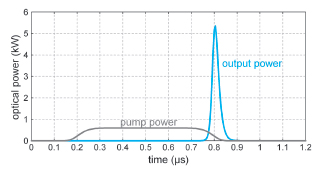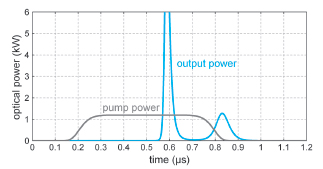Optipedia • SPIE Press books opened for your reference.
Gain Switching
Excerpt from Field Guide to Laser Pulse Generation
In contrast to Q switching, where the resonator losses are modulated, gain switching is the generation of short optical pulses by modulating the pump power. Because laser operation starts with some low level of fluorescence light, which first needs to be amplified in a number of resonator round-trips, the pulses are emitted with some temporal delay. This allows the deposition of some amount of energy in the gain medium, before that energy is extracted in the form of a short pulse. The pulse duration can be well below both the pump pulse duration and the upper-state lifetime of the gain medium.
Gain switching can be applied to different types of lasers:
TEA CO2 lasers are pumped with short current pulses and then emit pulses with durations of tens of nanoseconds-possibly shorter than the applied current pulses.
A solid-state laser can emit a nanosecond pulse when it is optically pumped only for a few microseconds. This is less frequently done, as Q switching is a more powerful option.
A dye laser can be pumped with a pulsed nitrogen ultraviolet laser or an excimer laser.
Small laser diodes can generate pulses with durations of tens of picoseconds (or sometimes even only a few picoseconds) when operated with short current spikes or with a sinusoidally modulated signal. Between the pulses, the pump current can be kept nonzero but somewhat below laser threshold. Although the pulse energy is small, such gain-switched laser diodes can be used, for example, as seed lasers in combination with fiber amplifiers.
In order to obtain a single output pulse, the parameters of the laser and the pump pulse need to be carefully adjusted.

The figure above shows the simulated power evolution for a gain-switched solid-state laser. A further increase of the pump pulse energy (with constant pump pulse duration) would lead to premature emission of the laser pulse, and so a secondary pulse can occur (see the figure below).

A solution would be to make the pump pulses shorter. Alternatively, the laser resonator could be made longer.
R. Paschotta, Field Guide to Laser Pulse Generation, SPIE Press, Bellingham, WA (2008).
View SPIE terms of use.

